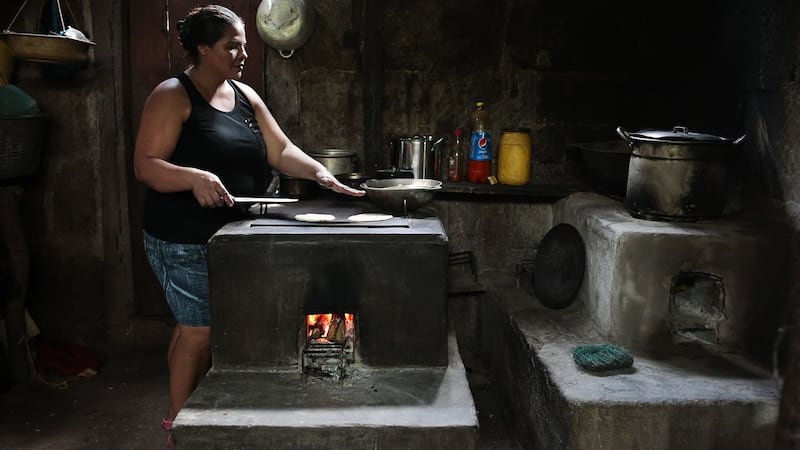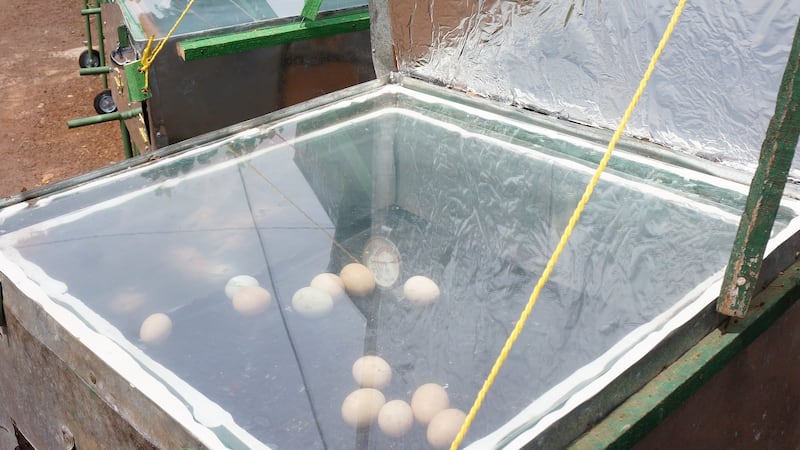For most of her life Dina Leiba got up in the dark, and went to bed in the dark. If she needed to get up to look after a sick child, she reached for a torch – if she had money for batteries. To charge her phone, she had to walk to a village with electricity, pay for the privilege, and walk home again.
Today she got up before dawn, turned on her solar lights and fired up her woodstove to bake bread to sell to her neighbours. It’s just three months since she got her solar panel, and life has changed in more ways than she could have imagined.
In the past, rather than playing outside when they came home from school, her children had to do their homework before the light faded. Now her son could be any teenager, anywhere. While we chat over guavas from Dina’s garden, he’s sitting in a corner of his bedroom, glued to a tablet, playing a videogame.
“I’m already learning that I have to set limits!” Dina says, rolling her eyes. “Before, the latest they would stay up was 9pm. Now I have to nag them to switch off the screen and go to bed.”
In the high mountains of Nicaragua, installing solar power and living off-grid aren’t lifestyle options for those escaping the rat race, or doing their bit to fight climate change. They’re a practical way of getting access to electricity in places that still aren’t connected to the national grid.
While rural electrification is proceeding rapidly under Daniel Ortega’s government, 10 per cent of Nicaragua’s population are still cut off, mainly those living in remote, poor areas. Mini grids, small-scale hydro and individual solar panels are some of the ways to fill in the gaps.
Dina, who lives in Yale village, in the municipality of El Tuma-La Dalia, got her solar panel through a donation from Electric Aid, the staff charity of the ESB, which partnered with the aid agency Trócaire and a local co-operative for the project.
Access to water
“What’s interesting is that it’s a combination of credit and donation,” says Martin Larrecochea, country manager for Trócaire. “The people who receive the panels pay back half the cost over 18 months, so they get the panel, the battery and the other elements for around $250 altogether.” The microcredit model has taken off across Nicaragua.
Before we got this, we had to walk five kilometres to El Chocote to get water during the dry season
While acknowledging the real difference these projects can make to people’s lives, researcher Lena Jaspersen of Leeds University suggests that the aid industry sometimes oversells the benefits.
“The idea that two lightbulbs in someone’s house is going to change the rural economy just isn’t correct,” she says. “And you have to evaluate these projects after a few years have passed, because while it’s relatively easy to set these up, it’s much harder to support and maintain them over time. Not everyone can afford a replacement battery when the time comes.”

Nevertheless, some villages have been even more ambitious in their adoption of solar power. El Balsamo is a bone-jarring hour’s drive from the nearest paved road. Getting there involves crossing four rivers, which are sometimes impassable in the wet season. Donald González is up on the roof of a small structure which houses the half dozen solar panels that run the village pump. Now 39 homes have running water.
“Before we got this, we had to walk five kilometres to El Chocote to get water during the dry season,” says his wife Eusebia. “We women did that for eight years, day in, day out, getting up at five every morning, waiting our turn, then walking back”.
Village roofs are dotted with solar panels, which sometimes sit alongside a satellite dish, but Eusebia’s older neighbour Reina has no electricity of any sort.
“My children are in Costa Rica, cleaning cars to feed me,” she says, shaking her head.
Tiny shafts of light enter Reina’s house through holes in the roof. This is also the only way the smoke from her open cooking fire can escape. Her kitchen walls are black; respiratory disease is one of the biggest killers of women in Nicaragua.
You could fry an egg on the stones here, if you had an egg, or as I'm about to discover, you could hard-boil them in your own hand-built oven
“My kids are going to build me a new house,” she says, “and I’m going to have a solar panel and a new, improved oven.”
Many NGOs distribute more efficient woodstoves, which use less wood, and install flues to help the smoke escape. But others have gone further, teaching women how to be self-sufficient using the power of the sun.
Hand-built ovens
In a poor barrio of the tourist city of Granada, on a sweltering Saturday morning, a half dozen women – and one man – are hammering out oven lids and covering them with foil. You could fry an egg on the stones here, if you had an egg, or as I’m about to discover, you could hard-boil them in your own hand-built oven.

Ruth Romero has spent the past week at this workshop and her oven is almost ready. It’s essentially a metal box on a trolley with a glass top. The sun beats down on to the open hinged lid and reflects onto the glass, which heats the cooking drawer to about 200 degrees.
“It’s going to save me money, because I won’t have to buy firewood, and its better for my health,” she says. “I’m going to make a cake when I get home, and the teacher, who’s a vegetarian, has taught me how to make chorizo from soy.”
Ruth puts a dozen loose eggs into the cooking drawer, and within 10 minutes they’re done and ready to be shared around, a celebration of a hard week’s work.
“People don’t just learn how to build an oven here,” says Mercedes Álvarez from Fuprosomunic (the Foundation of Nicaraguan Women Working on Solar Projects), who co-ordinates the project. “They talk about everything from nutrition to domestic abuse. This is how we stay together, we cook together”.
Susan Kinne, a professor of engineering in Managua, who has spent decades working on sustainable development, believes that these projects work by paying close attention and recognising what people need.
“The final product is really dignity. It’s about helping people to live a life that uses the human and natural resources that are around them, with the appropriate level of technology”.
In Nicaragua at least, nothing is more appropriate or available than the sun.
Back in El Balsamo the national grid has finally arrived, and Eusebia has hooked up to it. She has bought a fridge and has joined the informal economy, selling a new homemade product that’s bringing in school kids from miles around – a frozen chocolate-covered banana. But she would never give up her solar panel.
“First of all we get blackouts all the time here – storms, floods, you name it,” she says. “Secondly once you’ve paid for it, there’s no monthly bill.” Eusebia seems far too practical to give in to hyperbole, but on the subject of solar power she is positively evangelical.
“The solar panels were like light from heaven,” she says. “We were completely in the dark before we saw the light.”
This article was supported by a grant from the Simon Cumbers Media Fund









